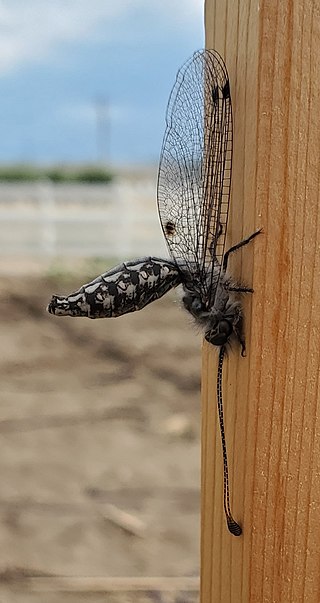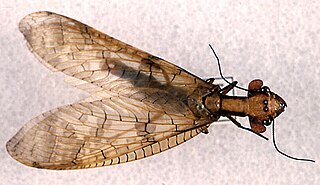
Dobsonflies are a subfamily of insects, Corydalinae, part of the Megalopteran family Corydalidae. The larvae are aquatic, living in streams, and the adults are often found along streams as well. The nine genera of dobsonflies are distributed in the Americas, Asia, and South Africa.

Alderflies are megalopteran insects of the family Sialidae. They are closely related to the dobsonflies and fishflies as well as to the prehistoric Euchauliodidae. All living alderflies – about 66 species all together – are part of the subfamily Sialinae, which contains between one and seven extant genera according to different scientists' views.

Ascalaphini is the type subfamily of the neuropteran owlfly family. Most species are found in the tropics. Their characteristic apomorphy, shared with the Ululodini, is the ridge which divides each of their large compound eyes; both groups are thus sometimes known as split-eyed owlflies. The group has been alternatly treated as a subfamily of Ascalaphidae, when the family is treated separate from Myrmelontidae, or as a tribe, when the ascalaphids are treated as a subfamily in an expanded Myrmelontidae.

Chrysoperla is a genus of common green lacewings in the neuropteran family Chrysopidae. Therein they belong to the Chrysopini, the largest tribe of subfamily Chrysopinae. Their larvae are predatory and feed on aphids, and members of this genus have been used in biological pest control.

Chrysopinae is the nominate subfamily of green lacewings in the insect family Chrysopidae in the order Neuroptera. This subfamily is also the largest within the family and comprises about 60 genera.

Bittacus is a genus of hangingflies in the order Mecoptera. Members of the genus have a cosmopolitan distribution. The genus has existed since at least the earliest Late Cretaceous. Bittacus is considered "grossly paraphyletic" and serves as a catch-all for many distantly related species of hangingflies.

Sympherobius is a genus of brown lacewings in the family Hemerobiidae. There are at least 50 described species in Sympherobius.

Chrysopini is a tribe of green lacewings in the family Chrysopidae. There are about 32 genera and 926 described species in Chrysopini.

Ululodes is a genus of owlflies in the tribe Ululodini. There are 26 described species in Ululodes.

Glenurus is a genus of antlions in the family Myrmeleontidae. There are about 12 described species in Glenurus.

Megalomus is a genus of brown lacewings in the family Hemerobiidae. There are more than 40 described species in Megalomus.

Apertochrysa is a genus of green lacewings in the family Chrysopidae. There are 183 described species in the genus.

Amphigerontia is a genus of common barklice in the family Psocidae. There are more than 30 described species in Amphigerontia.

Platyneuromus is a genus of dobsonflies in the family Corydalidae. They are found in Mexico and Central America.

Acanthacorydalis fruhstorferi is a species of dobsonfly native to Vietnam and China. It holds the title of largest aquatic insect by wingspan according to the Guinness Book of World Records at 21.6 cm. The title formerly belonged to the Brazilian damselfly Microstigma rotundatum.

Neoneuromus is a genus of dobsonfly endemic to the Indomalayan realm with 13 species. The larvae breed in montane streams. Adults are large with a forewing of 43 to 68 mm length and the body is yellow to red or brown with black marks on the head and pronotum. The wings are marked in dark patterning in the membrane and along the veins. They are closely related to Nevromus from which they are separated by the attenuation of the 9th sternum with an incised tip.

Psococerastis is a genus of insects belonging to the family Psocidae.
Syngenes is a genus of antlions belonging to the family Myrmeleontidae.

Parachauliodes is a genus of fishfly in the family Corydalidae. They are present throughout Eastern Asia, likely originating on the Korean peninsula before dispersing to the Japanese archipelago 15 mya.


















